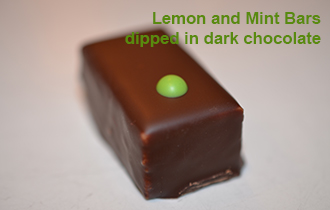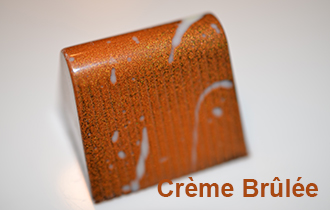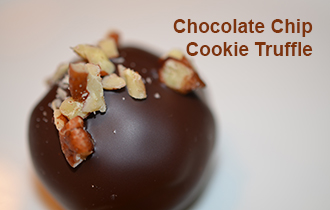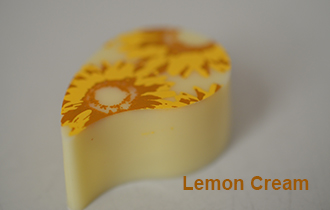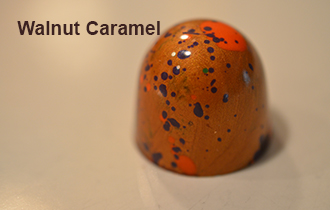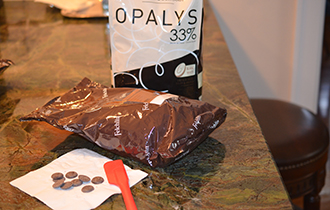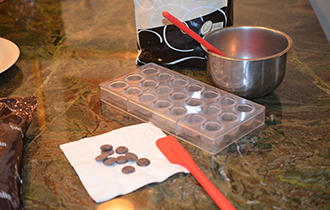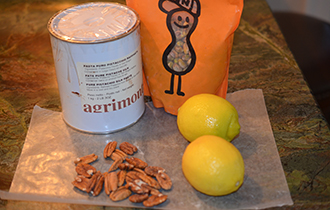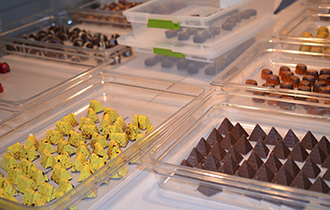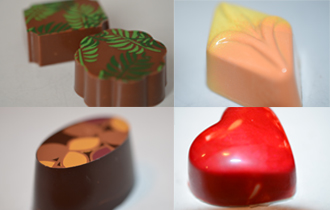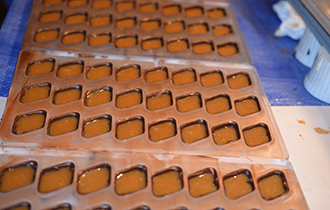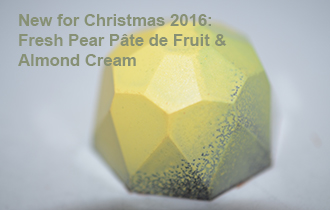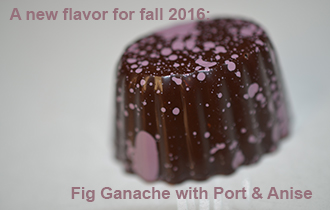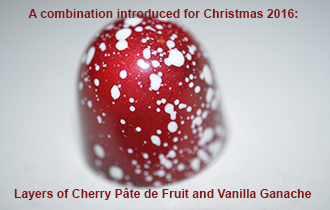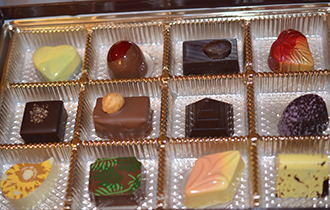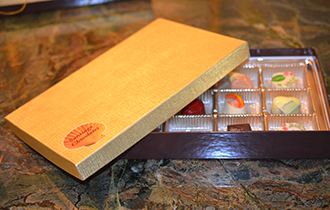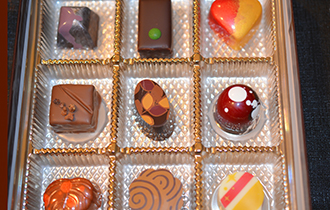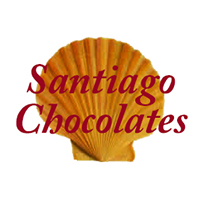
James T. Dutton
200 Austin Avenue, Staunton, VA 24401
Email: info@santiagochocolates.com
Telephone: 540-885-1845
Follow us: 
![]()




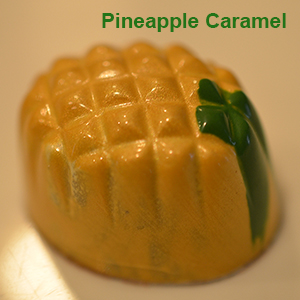
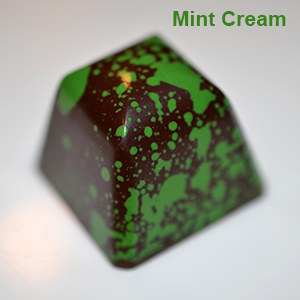
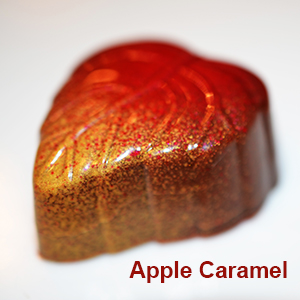
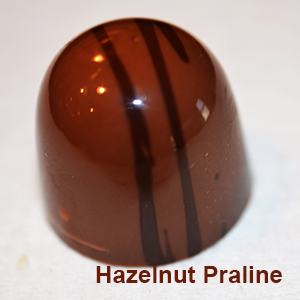
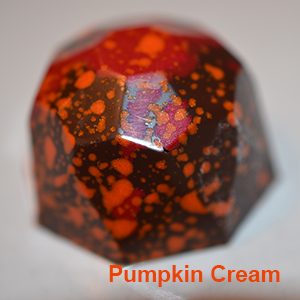
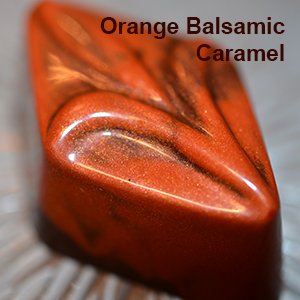
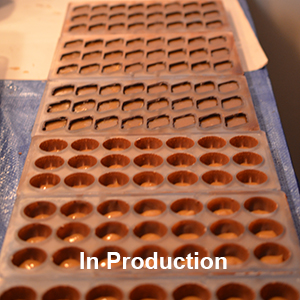
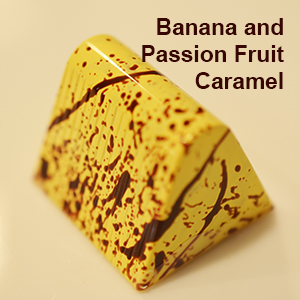
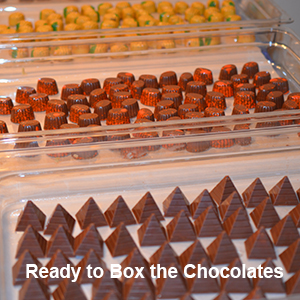
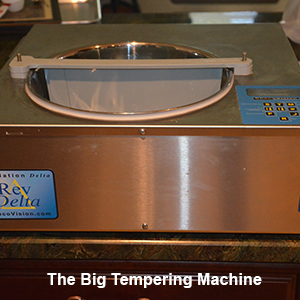
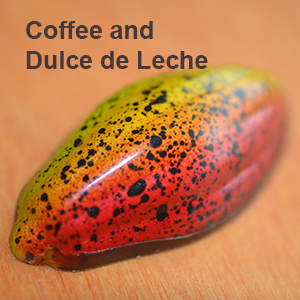
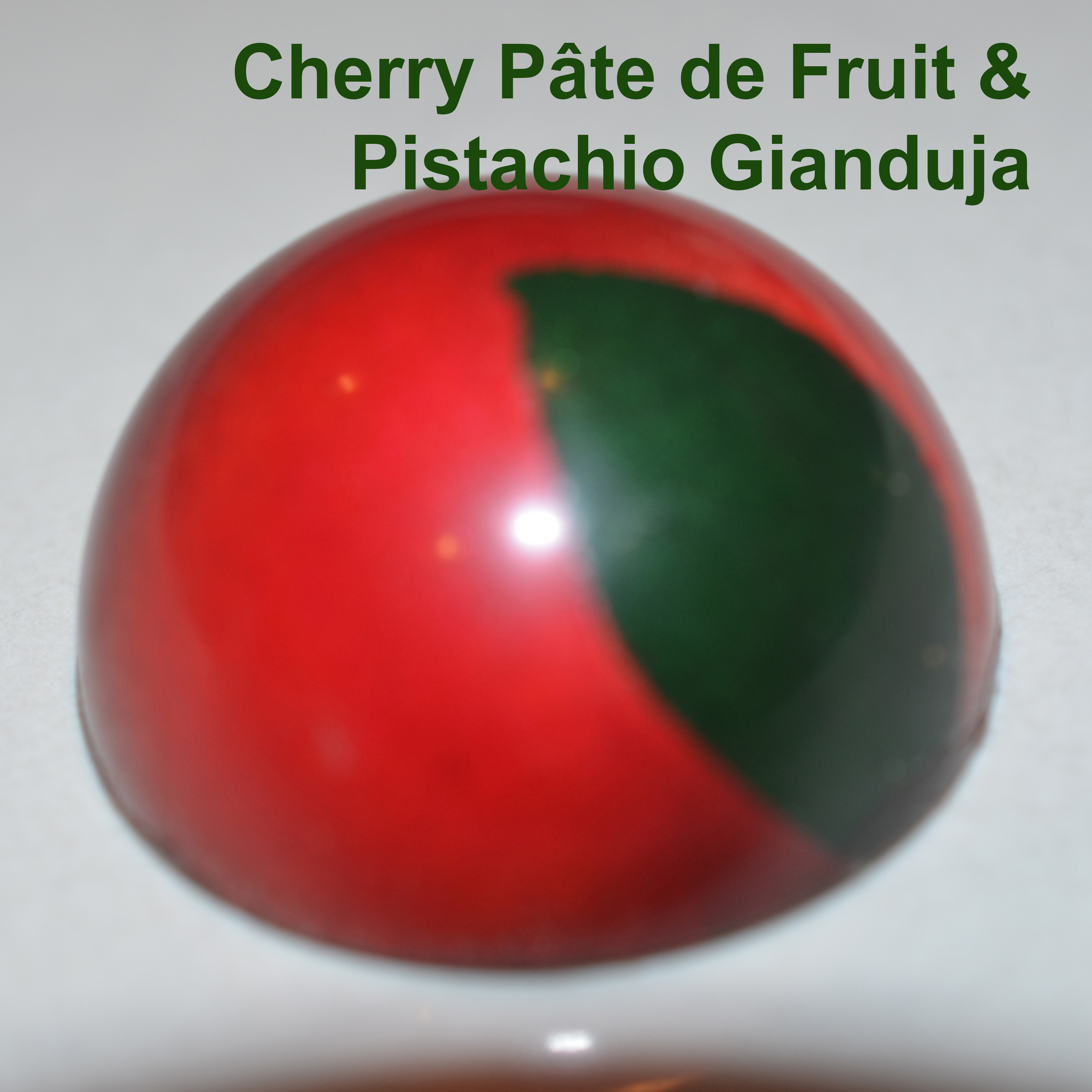
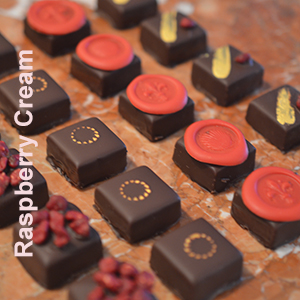
Welcome to the website of Santiago Chocolates. I have been involved in chocolate-making since 2012, with the chocolates initially going mostly as donations to church bake sales and as gifts to friends and family. After some recipients began asking to purchase the chocolates as Christmas gifts, I became a licensed and inspected business in the city of Staunton, Virginia.
When you get it right, you feel like you really accomplished something that day. I feel like everyone who specializes in chocolate must be a little bit crazy.
Chocolatier Kate Weiser
A word about the name of the business: People have asked about the source of the name. It is really just a play on my first name—Iago is Spanish for James; thus Santiago is “Saint James” (I do not lay claim to the honorific part of the name). The scallop shell I use as a logo stems from Santiago de Compostela, the shrine located in Spain in a city of the same name where, according to tradition, the Apostle James is buried. Pilgrims who walk the “Way” (Camino in Spanish) of St. James to Compostela carry the shell as a sign of their pilgrimage. Pilgrims travel this route to the present day, as was depicted well in the 2010 film “The Way” that starred Martin Sheen.
The freshness of the chocolates is of paramount importance to me, and for that reason I make them on primarily a monthly basis for a customer email list and for sale in several downtown Staunton locations. Those interested in purchasing the chocolates can check the Purchasing tab of this website for future dates when they will be available. The easiest way of being informed is by emailing me with a request to be added to the mailing list. I offer chocolates “between batches” from my home; these have been frozen to preserve their taste and require a day’s notice so that they can be brought to room temperature slowly. Contact me by phone or email if you would like to make a purchase. And finally the chocolates are sold, in boxes of six and twelve pieces, at Cranberry’s Grocery & Eatery, located at 7 South New Street in downtown Staunton, Virginia, and are on the dessert menu at Zynodoa restaurant on East Beverley Street and also at The Ridge Room, located on the top floor of the Hyatt Place hotel in Harrisonburg.
I invite you to explore other sections of this website to learn more about the ingredients I use, the recipes I follow, and the details of the production process.
Among the chocolates I make are traditional ones, such as peppermint cream and salted caramel, but I also like to experiment with new and unusual flavors, such as yuzuYuzu, the most popular citrus fruit in Japan, has a tart flavor resembling that of the grapefruit, with overtones of mandarin orange. and kalamansiKalamansi, also called calamondin, is a citrus fruit with sour flesh but a sweet skin. Used widely in the Philippines and nearby areas, it tastes like a combination of lemon and lime but with more aromatic overtones., and I particularly enjoy trying to capture familiar flavors in the tiny confines of a chocolate shell (pumpkin pie, plum pudding, crème brûlée, pecan pie, lemon meringue pie, s’mores, apple crisp, and chocolate chip cookie come to mind). The summer, when chocolate-making is quite difficult because of the weather, is the time I experiment with new flavors and new combinations (see more information under the What’s New tab). Here are examples of various chocolates I have made:
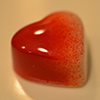
cherry with kirschwasser
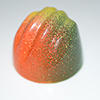
citrus (orange, lemon, lime)
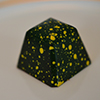
peppermint cream
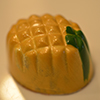
caramelized pineapple
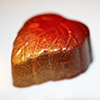
apple caramel
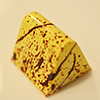
banana and passion fruit caramel
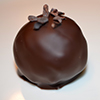
chocolate chip cookie truffle
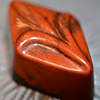
orange caramel with balsamic vinegar
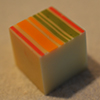
yuzu and ginger
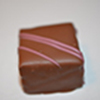
crispy hazelnut and black currant
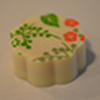
strawberry and rhubarb
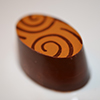
spiced pumpkin cream
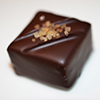
gingerbread with muscovado sugar
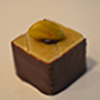
pistachio gianduja and marzipan

blackberry jelly and dark chocolate with orange
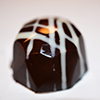
layers of dulce de leche and coffee
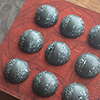
Earl Grey tea ganache
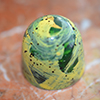
crème brûlée
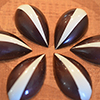
fig with port and anise
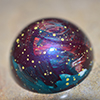
absinthe-flavored ganache
Hover cursor over a filling name to view a description.
It may be of interest to some to know about the ingredients I use for the chocolates. I am always trying new couverturesCouverture is the French term for high-quality chocolate used to make shells for molded pieces and to dip centers; it can be purchased as dark, milk, and white., attempting to find a balance between taste and viscosity. When a chocolate becomes too viscous, it is impossible to use successfully in the work I do. Taste, however, is paramount.
I (and most of my customers) like a dark chocolate that is definitely in the bittersweet category but is not so bitter that it overpowers the filling it encloses. Felchlin’s Maracaibo Clasificado is my regular dark couverture; Felchlin is a very old Swiss chocolate maker. The percentage of cocoa solids in Maracaibo is 65% (as a way of comparing, many of the really dark couvertures are in the 70% range). On occasions when a darker chocolate seems appropriate, I use Arriba (72%), also made by Felchlin. Once a year, usually at Valentine's, I produce an all-dark chocolate assortment intended especially for the dark chocolate aficionado.
I find that selecting a milk chocolate is even more difficult. Milk chocolate has many more added flavors than does dark; depending on what has been added, it may lean toward a dairy flavor (think hot chocolate) or a caramel flavor or a malted flavor. I have experimented with many milk chocolates but have settled on Felchlin’s Maracaibo Créole (the same chocolate used for the dark discussed above plus dairy solids); it has 49% cacao).
White chocolate is the real problem. Cocoa butter is the crucial ingredient in all chocolate, but white chocolate is made without any other parts of the cacao pod that give dark and milk chocolates their characteristic flavor and is thus—more than dark or milk—a creation unique to the company that makes it. If the taste of cocoa butter predominates, you have something that is (in my opinion) too close to Wesson Oil to be palatable. The flavors of white chocolate come primarily from dairy solids and vanilla added to cocoa butter. Many people (including some of my customers) are scornful of white chocolate, and many do not consider it “real” chocolate; others like its sweeter profile. There is no question that white chocolate pairs best with many flavors, particularly fruit ganachesGanache is the French term for the fillings most often used in chocolates. Usually it is an emulsion of cream and chocolate, but other liquids may be substituted for the cream.. For example, a delicate flavor like pear or apple can be overwhelmed when the ganache is made with dark chocolate. At this time I use Valrhona’s Opalys white chocolate. It fulfills one of my requirements—that it have a good taste—but unfortunately it is a very viscous substance and therefore quite difficult to use. I have tried several other whites but have found that all others taste too much of cocoa butter. Whatever combination of flavors Valrhona has used in Opalys, it has made what I think is the best-tasting white, and so I put up with the difficulty of working with it. Incidentally a chocolate expert I know through an online forum was going to Valrhona headquarters (near Lyon, France) in 2015 and volunteered to ask them about this issue. To my surprise (and relief), the manufacturers of the chocolate acknowledged the problem and provided a few hints to make working with Opalys a little less stressful. So Opalys it is for white chocolate shells—at least until a better-tasting and friendlier white comes along.
For fruit-flavored ganaches used in the chocolates, I use frozen fruit purées (for the more exotic fruits, such as passion fruit, yuzu, and kalamansi), which must be flown in overnight. I make my own purées for fruits that I can procure locally (strawberry, raspberry, rhubarb, and pear). One of my most exciting finds was at the local farmers’ market, where one of my favorite vendors grows ginger so tender it barely needs peeling, and I also managed to obtain maple syrup from a producer in nearby Highland County. Apple purée is too subtle to show up in the apple caramel I make, but, again thanks to someone on the online forum I mentioned above, I found a Vermont apple cider jelly (made solely from apple cider boiled down until it jells) that works quite well. I have online sources for the nuts and other ingredients I use in fillings. A Rhode Island online vendor carries many hard-to-find ingredients used in chocolate-making (such as invert sugar, glucose syrup, and hazelnut praline paste). A seller in Las Vegas makes the colored cocoa butters used in decorating some of the chocolates and sells other specialty ingredients like citric acid and fruit pectin).
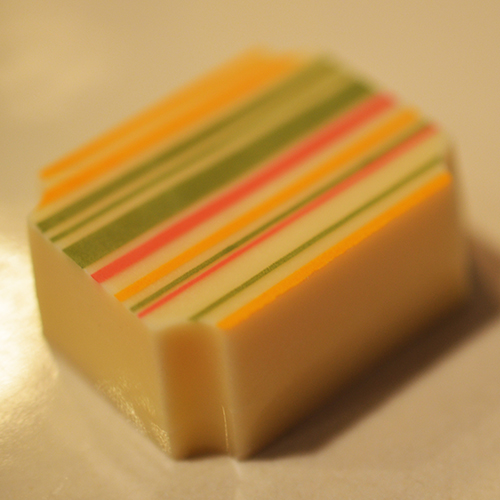
A magnetic mold lined with a transfer sheet was used to produce this bonbon.
Decorating Chocolates: Transfer Sheets. Most European chocolatiers do not decorate their molded chocolates with colored cocoa butter, but the practice has caught on in the U.S. Decorating in this way adds not only a layer of splashy color to the finished item but a layer of complication to the process as well. It is not uncommon for the decoration to stick to the mold and cause an unsightly exterior. One nearly foolproof way to add color is to use “transfer sheets,” sheets of flexible plastic on which cocoa butter has been “painted” in a design; these can be purchased or can be made by the chocolatier. This type of decoration requires a special mold which has a removable bottom attached by magnets to the top, and thus the transfer sheet can be placed between the bottom and the top of the mold. When warm chocolate is poured into the cavities, the design is transferred to the bottom of the bonbonBonbon is a term referring to individual chocolates, both those molded in shells and those dipped in chocolate.. After the filling has been added and the chocolate has crystallized, the mold is inverted, the magnetic bottom is removed, and the individual chocolates pop out, now with the design on top.

The leaf bonbon was decorated by using an airbrush to spray the mold with red, gold, and green cocoa butters.
Other Methods of Decorating Molded Bonbons. In addition to employing transfer sheets, there are other methods of applying color. For pieces with several colors blending into each other, I melt the already-colored cocoa butter and attach the container to an airbrush, a tool that uses compressed air to force the cocoa butter through the airbrush nozzle to create a fine mist covering the bottom and sides of the molds. This is not only a messy process but one that is quite removed from the purpose of an airbrush (which is to spray paint in a fine mist). The difference between paint (which stays the same consistency the entire time it is being sprayed) and cocoa butter (which, as it cools, rapidly thickens) is enormous; the latter requires frequent use of a heat gun to keep the airbrush warm enough to maintain the cocoa butter’s liquid state. But airbrushing does produce some amazing effects. In the photo of the leaf bonbon on the right, it was possible to mimic the colors of an autumn leaf; I use this design to hold apple-flavored caramels.

A bonbon decorated by piping thin lines of white chocolate into the mold, followed by dark chocolate
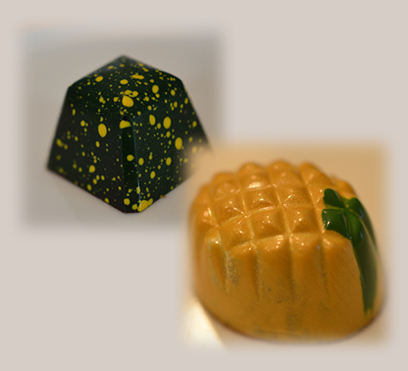
The chocolate on the left, containing a mint ganache, was sprayed with green cocoa butter accented with splattered yellow; the other piece, with a caramelized pineapple filling, was hand-painted to simulate a pineapple.
There are many other techniques for decorating molds, such as making colored swirls in the mold with a gloved finger, using a paint brush to create designs in the mold, splattering the mold with various colors, or moving a pastry bag holding a contrasting color of chocolate back and forth over the mold to create lines that will later blend into the chocolate enrobing the filling (see the dome bonbon at left). In the photo at right, there is an example of splattering with cocoa butter and of painting with a brush.
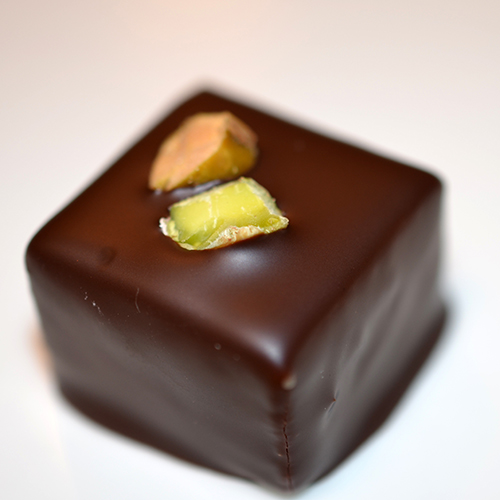
A dipped chocolate containing pistachio ganache, the top decorated with toasted chopped pistachios
Decorating Enrobed Bonbons. For ganache cut into pieces and dipped in chocolate, a decoration reflecting what is inside is often added to the top before the dipping chocolate has a chance to harden. Thus a pistachio ganache might have toasted pistachio nuts on top, or an orange ganache might be decorated with fine lines of white chocolate tinted orange.
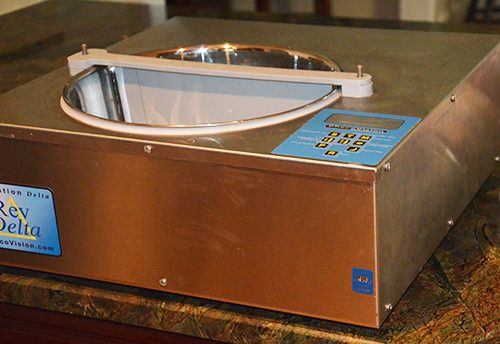
The large tempering machine
Tempering Chocolate. Chocolate must be “tempered” (or “pre-crystallized”) before it can be used to mold shells or enrobe centers. The explanation of this requirement is quite complex, but the main point is that of the six types of crystals (labeled I-VI) present in cocoa butter, Type V is the crucial one, the one that gives chocolate its snap and shininess, keeps it from melting easily in the hand, and—perhaps most importantly—causes it to contract and so come out of a mold. For a batch to arrive at the point where Type V crystals predominate, it is necessary to melt out the others (primarily Types I-IV) and encourage Type V crystals to grow. This is the process of tempering (or pre-crystallizing). It can be accomplished by hand, and I do this for small amounts, but for larger projects I have two tempering machines, a smaller one holding 1.5 pounds of chocolate and a much larger one that can handle up to 17 pounds. The temperer first heats the chocolate (which can be either new or left over from previous projects) to a temperature at which all the crystals melt (somewhere over 108° F., depending on the type of chocolate and the manufacturer’s recommendation). Then the mass is “seeded” with already-tempered chocolate (often taken from the bag in which it originally came), and the temperature is lowered to the tempering point (approximately 90° F. for dark chocolate, 86° for milk, and 84° for white). If the temperature falls much below those points, the chocolate will become quite difficult to work with. The machine performs this process more or less by itself, freeing me to do other preparation in the kitchen. For chocolates made in molds, I fill a mold to the top with the tempered chocolate, tap it on the counter to remove air bubbles, let the chocolate set for a minute or so, then turn it upside down and knock out most of the chocolate, a process that leaves a thin shell to hold the filling at a later point. For scraping excess chocolate from the molds I have a number of tools, the most important of which are like scraping tools used in drywall work. As work with a batch of chocolate continues, the Type V crystals multiply and cause the mass to over-thicken. With the Opalys white chocolate mentioned prevously, this process happens rather quickly. Measures must be taken to correct this situation (which is called “over-crystallization”), usually involving an increase in heat a degree or so but sometimes requiring more drastic action, such as adding melted untempered chocolate to the machine to dilute the Type V crystals. Frequent testing to make sure the chocolate remains in temper is necessary; failing to do so can result in chocolate that will not release from the mold. A few episodes of cleaning out molds with untempered chocolate (especially because it is unwise to allow chocolate into a drain) tend to encourage the chocolatier to take the time for testing.

A guitar for cutting ganache slabs into smaller pieces to be dipped in chocolate
For chocolates in which centers are enrobed in tempered chocolate, the ganache is poured into a frame (mine is made of movable stainless steel bars to form a variably sized rectangle) and then allowed to crystallize (firm up), after which it can be cut into squares or rectangles or even diamonds. Using a long sharp knife to cut the slab into pieces seems obvious, but this method inevitably results—unless one is an accomplished geometrician or carpenter—in some squares that are not square, or worse. The solution to this problem is to use a “guitar,” which consists of a platform on which the slab of ganache is placed and an attached frame containing parallel wires (thus resembling a guitar). The frame with wires is lowered through the slab, cutting it into long pieces. The slab is then rotated 90° and cut again to form squares (or various rectangular shapes). If all goes well, this process creates perfect pieces that make beautiful dipped items. My smaller tempering machine is the right size for creating a small but deep pool in which to dip the pieces. Enrobing is a painstaking process requiring a great deal of patience to end with pieces that do not harden with a pool of chocolate (called a “foot”) around the base.
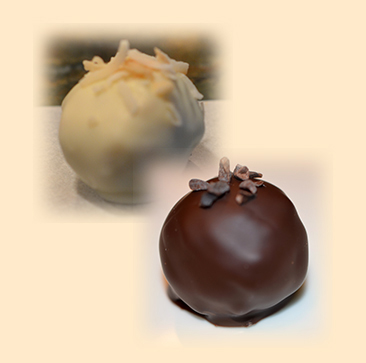
Because of their ingredients, the coconut macadamia nut filling and the chocolate chip cookie filling are most successfully made as truffles.
Dipping truffles is a slightly different process from that used for ganache centers. The word “truffle” is sometimes used as a generic term for filled chocolates, but more strictly it refers to pieces in which a filling, which can be somewhat soft and can contain ingredients that cannot be cut safely with a guitar or neatly with a knife (such as chocolate chunks or nuts or coconut), is rolled in a spherical shape and dipped in chocolate. Since the centers to be used for truffles often have irregular surfaces, they usually require two coats of chocolate for full coverage. The truffles pictured at left were first rolled in chocolate (in the palm of a gloved hand), allowed to set, then dipped in more chocolate for a smooth finish. Decorations (toasted coconut and cocoa nibsMade from whole raw cacao beans crumbled into small chunks, cocoa nibs add a crunch as well as a contrasting strong dark chocolate flavor to an item that might otherwise be very sweet. in these cases) are added before the chocolate sets.
Recipes.The recipes for my ganaches and other types of fillings (such as caramel) come from many sources: Peter Greweling, Ewald Notter, and Jean-Pierre Wybauw are three widely recognized chocolatiers and teachers, and each has published books with useful recipes that I employ quite often. In some cases I have discovered that I like a slightly different taste or consistency and have made changes to the recipes. Other recipes come from online sources, primarily from eGullet, the forum mentioned previously that deals with all aspects of food and draws contributors who are amazingly willing to share what they know about chocolate. Without this forum I would never have learned what I know about making chocolates, and I am grateful to those who have answered my questions over the years. And finally I have come up with a few of the recipes myself, usually based on an idea I found somewhere online; chocolate chip cookie is an example. All the recipes are entered into a database so that I can adjust the amount of ganache I make. For example, if a recipe makes 600 grams of ganache, I know that the amount will fill two of the molds I use, but if I want to fill just one mold, I can enter 50% as the amount to be made and the ingredient quantities will be adjusted accordingly. I can print out the recipe from the database so as to have the adjusted amounts in front of me—and prevent ruining the book I am using with stray chocolate. If I have leftover ganache, I vacuum-pack and freeze it; when I need to make a few chocolates with the leftovers, the database can tell me how many cavities I can fill with the amount of ganache I have on hand. In addition, the database can be used to format the ingredients for a given batch of chocolates so that I can print a shopping list and can also tell me how much dark, milk, and white chocolate I need to order to pour the shells and dip the centers. I am also able to print labels listing the ingredients in each batch of chocolates, something required for sale in retail locations.
Storing the Chocolates. I am concerned about shelf-life as I have learned that some customers stretch out a box of chocolates for a long time. I have a meter that tests the water activity of each ganache, a measurement that correlates to the period of time when the chocolate will be safe and will also taste good. Most pieces have an estimated shelf life of 2-3 weeks following the date of production. Beyond that, I suggest tightly wrapping them in plastic and refrigerating. This practice is not recommended among high-end chocolatiers because it can result in condensation from the refrigerator, but my thought is that if people are going to keep the chocolates longer than recommended, I want them (both the people and the chocolates) to be safe. I enclose directions on storing the chocolates with each box. For longer storage the chocolates may be frozen, and on request I can furnish suggestions for making that process as successful as possible. When I have extra chocolates from a batch, I put them into boxes of various capacities so as to have them available for sale if customers have a need for chocolates “between batches.” These boxes are sealed in plastic bags and then frozen, a process that keeps them perfectly.
The images above show some of the chocolates I have developed. I often use a pâte de fruit (fruit jelly) as one-half of two-layer pieces; apricot, cherry, raspberry, and pear are some of the flavors included. I also use these jellies in “crisps,” which are multi-layered bonbons using, for example, apple, apricot, or cherry, togther with a vanilla layer and a crunchy layer of various cookies.
In fact, I have begun adding crunchy layers to many bonbons; the crispness contrasts well with softer fillings, such as ganaches. Examples include pineapple caramel with a ginger cookie layer; strawberry gel with a msrshmallow and a strawberry cookie layer; coffee ganache with a ladyfinger layer (tiramisù); pecan praline gianduja with a spiced cookie layer (pecan pie). Recipes for such bonbons require much forethought as layers intended to remain crunchy must be free of water content (no butter, no cream, no fruit); otherwise the crisp items turn to mush.
Customers often ask where I get ideas for bonbon fillings. Many I have found in books on chocolate from experts such as Peter Greweling, Ewald Notter, and Jean-Pierre Wybauw. Sometimes I find there are parts of a recipe that do not end up as delicious as they look on paper, and I must make adjustments. In recent years Instagram, Facebook, and Youtube have becomes sources for new filling ideas; it is amazing how many accomplished chocolatiers freely share their recipes and techniques. Other recipes I have developed myself, usually derived from a basic one that works. Baklava is one example. I found a recipe for pistachio gianduja (a mixture of finely ground nuts and chocolate) from famous chocolatier Melissa Coppel (who did a presentation in the workshop I attended in Las Vegas). Working with pistachio led me to think about the Middle Eastern dessert baklava and to consider whether its flavors could be incorporated into a bonbon. The requirement that the water content of a bonbon be low enough to inhibit the growth of bacteria is always the major consideration (fortunately I have a meter that measures the water in a filling). How to incorporate the crispy layers of phyllo dough that are always part of baklava was a major concern, but Coppel’s recipe introduced me to kataifi, a crispy dough that comes in shredded form, its texture resembling phyllo dough that has been crushed. So I embedded a little kataifi plus some toasted pistachios into the gianduja. But I could not add other traditional baklava ingredients (honey, rosewater) to that layer, else the crispy ingredients would turn soft. So to the bonbon I added a second layer, a pistachio ganache made of pistachio paste, white chocolate, and cream, plus cinnamon, honey, and a small amount of rosewater. As is the case with all recipes I develop, I pair the filling with dark, milk, and white chocolate to determine which works best. There are also various “tricks” one can use to counteract extreme sweetness in some fillings: For example, the maple walnut filling was tooth-achingly sweet until I piped a very thin layer of extra-dark chocolate into the bottom of each bonbon.
Baklava is one example of recipes recently introduced to my rotation that strive to mimic the taste of well-known desserts. Others are carrot cake, pecan pie, pumpkin pie, black forest cake, tiramisù, lemon and lime meringue pie, cinnamon bun, cheesecake (featuring various fruit toppings), bananas Foster, and s’mores.
The decorated and filled Easter eggs I first made in April 2017 have proved to be popular, and I have recently increased the number of filling choices to five. Customers appear to enjoy being able to specify what fillings they will get. Needless to say, salted caramel remains the customer favorite.
Information updated June 2024.
Availability and Purchasing Chocolates. I make chocolates at approximately monthly intervals. For those who have signed up for email notices, I send a message giving the due date and when that batch will be ready. Sometimes I also have a small number of boxes available between batches. So if you have an unanticipated need for chocolate—for a birthday celebration, an impromptu dinner party, an unexpected guest, even just a need for a chocolate fix—contact me a day in advance, and I will let you know about availability. Note that I do need approximately a day to bring the chocolates from freezer to room temperature slowly so that condensation does not form on them. You should not use the regular order form for these special orders; email or phone instead. With enough advance notice, I could produce chocolates for other occasions, such as parties and weddings. I have an email list of previous customers that I use to announce times when I will have the chocolates for sale from my home. If you wish to be added to the email list (or to be removed from it), use the link below to send the request.
Chocolates are available only to those willing to travel to Staunton, Virginia, for pickup; at this time I do not offer the option of shipping them.
Pricing. Boxes of chocolates purchased directly from me are ordinarily available in four sizes:
6 pieces for $15
12 pieces for $30
20 pieces for $40
30 pieces for $50
If you are picking up chocolates, I am located at 200 Austin Avenue, Staunton. A map for locating my house is available.
The next batch of chocolates will be ready by January 16; the due date for orders is January 2.
The chocolates are ordinarily available, in boxes of six and twelve pieces, at Cranberry’s Grocery & Eatery, located at 7 South New Street in downtown Staunton. It is advisable to check the hours and the availability of the chocolates at the shop.
The chocolates are on the dessert menu in two restaurants: Zynodoa in Staunton and the Ridge Room in Harrisonburg. They are also presented as a gift to overnight guests at Maude & the Bear, a restaurant and inn located in Staunton.
On occasion I have chocolates from a previous batch available in my freezer.
Storing the Chocolates. The chocolates will keep for approximately two weeks at their ideal storage temperature, below 60 degrees Fahrenheit. For storage for a longer time or in warm weather, they must be wrapped as tightly as possible in plastic and refrigerated. For storage for an even longer interval, freezing is the best choice. There is a recommended procedure for freezing, and not following it will likely result in condensation: Wrap the chocolates tightly in plastic. If possible, seal the bag in which they are stored. Once they are in the bag, refrigerate them for a day, then move them to the freezer. When thawing them for use, move them from the freezer to the refrigerator for a day, then to room temperature for at least several hours. Do not open the plastic bag until they have come to room temperature. This procedure will encourage any condensation caused by temperature change to form on the outside of the bag rather than on the chocolates themselves. If you know you will be freezing the chocolates, I can seal them in a plastic bag on request and at no additional charge.
